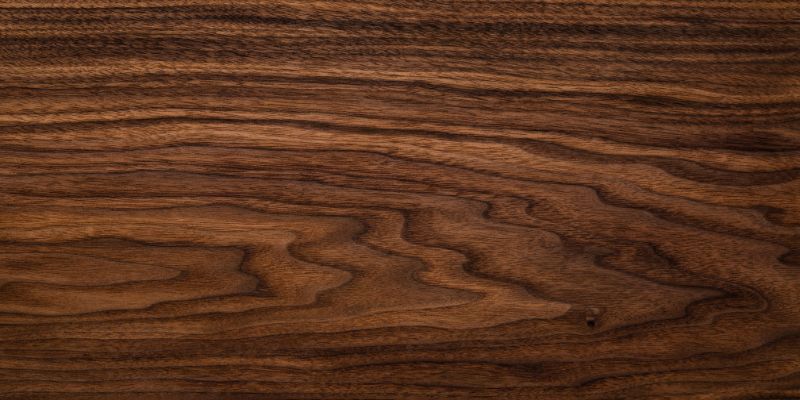Walnut wood, with its deep, chocolate-brown hues and intricate grain patterns, is a natural treasure that brings warmth and elegance to any project. Its tight, swirling texture—often accented with lighter streaks offers a rich, organic beauty that shines best when left unadorned by heavy finishes or over-processing. Whether you’re crafting furniture or adding accents to your home, walnut’s natural texture can elevate your space with understated sophistication.
This article explores six ways to use walnut wood texture naturally, offering practical ideas, insights, and tips to let its inherent charm stand out. From simple shelves to statement pieces, these methods celebrate walnut’s raw appeal with minimal fuss. Let’s dive into these natural approaches and bring walnut’s beauty to life in your home!
Walnut Floating Shelf: Grain on Display
A Walnut Floating Shelf showcases the wood’s natural texture as a simple, functional accent. Its exposed grain adds organic warmth to any wall.
- Cut a 1-inch thick walnut plank (e.g., 10×36 inches) and sand lightly with 220-grit to smooth without masking the texture.
- Leave edges raw or slightly rounded to highlight the wood’s natural lines and swirls.
- Seal with a clear, matte finish like tung oil to protect while preserving the grain’s depth.
- Mount with hidden brackets in a living room or kitchen for a sleek, floating look.
- Enjoy the way walnut’s dark tones and subtle patterns elevate books or plants.
Pro Tip: Position in natural light to accentuate the grain’s rich contrasts.
Budget Consideration: Use a shorter walnut plank or repurpose scraps.
Walnut Cutting Board: Textured Utility
A Walnut Cutting Board lets the wood’s natural texture shine as a kitchen essential. Its smooth grain doubles as both beauty and function.
- Shape a 1-inch thick walnut piece (e.g., 10×14 inches) with a jigsaw, keeping edges natural or gently curved.
- Sand with 120-320 grit to enhance the silky texture without over-polishing.
- Apply food-safe mineral oil to deepen the dark hues and protect the surface, letting swirls stand out.
- Use for light chopping or as a serving board for cheese and bread.
- Relish the tactile feel of walnut’s tight grain under your hands daily.
Pro Tip: Rub with walnut oil periodically to maintain its natural luster.
Budget Consideration: Craft from offcuts or smaller walnut pieces.

Walnut Wall Panel Accent: Organic Art
Walnut Wall Panel Accents use thin planks to create a natural, textured feature wall. The wood’s grain becomes a stunning, unadorned artwork.
- Arrange ½-inch thick walnut strips (e.g., 4×24 inches) vertically or horizontally on a wall section.
- Sand lightly with 220-grit to preserve the raw texture, avoiding heavy staining.
- Seal with a clear, non-glossy finish to protect while letting the grain breathe.
- Install in a bedroom or dining nook with adhesive or nails for a subtle accent.
- Appreciate how walnut’s dark swirls add depth without overpowering the space.
Pro Tip: Space planks slightly apart for a shadow effect that enhances texture.
Budget Consideration: Use reclaimed walnut or fewer planks for a smaller area.
Walnut Picture Frame: Rustic Elegance
A Walnut Picture Frame highlights the wood’s natural texture as a simple, elegant border. Its rich grain frames photos or art with organic charm.
- Cut 1-inch wide walnut strips (e.g., 1×12 inches) with a miter saw for a 4×6 or 5×7 frame.
- Sand with 180-320 grit to smooth while keeping the grain’s subtle waves visible.
- Finish with a light coat of clear wax or oil to protect and subtly darken the wood.
- Assemble with wood glue and clamps, adding a glass front and backing.
- Display on a shelf or wall, letting walnut’s texture enhance your memories.
Pro Tip: Leave outer edges rough for a rustic, natural contrast to the photo.
Budget Consideration: Use walnut scraps from larger projects.

Walnut Bench Top: Warm Seating
A Walnut Bench Top uses a thick plank to create a natural, textured seating surface. Its rich grain adds warmth to a simple bench design.
- Select a 1-2-inch thick walnut slab (e.g., 14×48 inches) and sand with 220-grit for a smooth, touchable feel.
- Keep edges natural or softly rounded to showcase the wood’s organic lines.
- Apply a clear, matte polyurethane to protect without hiding the texture’s depth.
- Attach to metal or wooden legs with screws, placing in an entryway or patio.
- Savor the inviting feel of walnut’s grain underfoot or hand as you sit.
Pro Tip: Burnish with a cloth after oiling for a subtle, natural sheen.
Budget Consideration: Source a narrower slab or repurpose old walnut.
Walnut Coaster Rounds: Miniature Charm
Walnut Coaster Rounds turn small wood discs into natural, textured drink bases. Their compact size lets walnut’s grain shine in everyday use.
- Slice a 1-inch thick walnut branch or plank into 4-inch rounds with a band saw.
- Sand lightly with 120-220 grit to smooth while preserving the grain’s swirls.
- Seal with a food-safe oil (e.g., mineral oil) to darken and protect the texture.
- Stack on a coffee table or use under mugs for a rustic, natural touch.
- Delight in the tiny showcase of walnut’s rich, dark beauty with every sip.
Pro Tip: Add a light burn design (e.g., initials) for a personal twist.
Budget Consideration: Use free branch rounds or scraps from other cuts.
Conclusion
Walnut wood’s natural texture—its tight grain, warm tones, and subtle swirls—offers a stunning canvas for home projects, and these six ideas prove its effortless beauty. From the sleek Walnut Floating Shelf to the cozy Walnut Coaster Rounds, each method lets the wood’s inherent charm take center stage with minimal intervention. Whether you’re crafting for function or decor, walnut brings a rich, organic elegance to any space.
Try one of these ways to use walnut wood texture naturally—grab a piece of walnut, some basic tools, and let its grain shine. With its timeless appeal and versatile warmth, these six ideas will inspire you to create pieces that celebrate nature’s artistry in your home, simply and beautifully!

